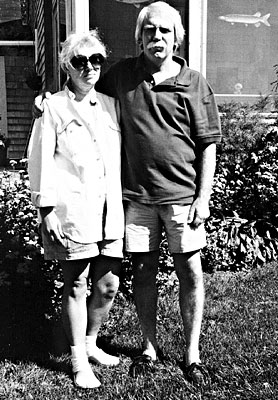 |
| Ellin and Stephen Sheehy have a diversified farm with a bed and breakfast in Alna. Lamb photo. |
By Jane Lamb
Imagine giving and receiving a little piece of Eden as a 25th anniversary present. Adam and Eve never had it so good. But Ellin and Stephen Sheehy did just that when they bought an old farm on the Alna-Whitefield town line six years ago, a place where they have been able to put to practical use years of creative pursuits and to find new ones to explore every day. Named in honor of the happy occasion, Anniversary Farm has become a charming bed and breakfast, a farm stand that offers the freshest possible organic produce, cut flowers, sauces and jams from their own kitchen, and a home place where they can savor the fruits of their labors in an idyllic setting.
That’s partly because the property they purchased wasn’t just any old farm, but one of the oldest in Alna – and living proof that the first settlers snagged the best sites in any given locality. Their 43 acres, half of the original farm’s 87, climb gently up a south-facing hillside laced with spring-fed streams and woodland glades. The streams fill a pond, site of the first fish hatchery in Maine and perhaps in the country. Narrow open fields, blessed with stone-free topsoil, rise between the woods to the top of the ridge. With a little stretch, one could almost picture Heidi and her goats scampering up the flower-covered slope. Half a mile down Route 218, road and streams dip into the Sheepscot Valley and the fork that crosses the river into the incomparable little village of Head Tide. And think what it might be like if they succeed in fulfilling a long-held dream of growing their own field of Provence lavender. No wonder the Sheehys advertise their B&B as “romantic country comfort!”
That wasn’t exactly what they found after several years of searching for a place in the Maine they’d fallen in love with while sailing down the coast. Appalled by the price of shore property, they turned their eyes inland. Largely through serendipity, they discovered the old Jewett-Pottle farm, which had been in the same family from the early 1800s until the 1980s. Bought then as an investment that didn’t work out, it had been abandoned for several years. “It was in rough shape,” Stephen recalls. “The renters had moved out, the pipes had burst, there was no functional heating or septic system, it needed a new roof, paint, everything.
“But the lilacs were in bloom and we picked asparagus here the day we came to look at it. It was a beautiful property,” says Ellin.”We were sold. We had built one house and remodeled four in different places while we were still living in Winthrop, Massachusetts. We were looking for a fixer-upper.” Already experienced in such matters, they were undeterred by the challenge they saw before them. They were willing and able to buy the place without the inspection contingencies required for a bank loan and got the farm at an excellent price from an absentee owner eager to unload it. “We bought it in July of 1993 for our 25th anniversary,” Ellin said last September. ”We just celebrated our 30th, and our fifth here.”
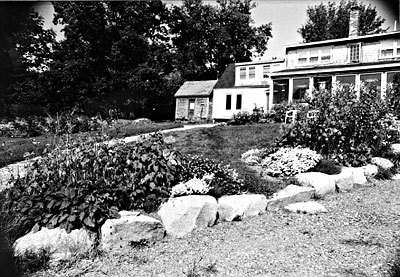 |
| Flowers border the drive and path winding to the main entrance on the sun porch. Lamb photo. |
Stephen spent weekends the first year just getting the house into livable condition, hiring local contractors for the exterior work and doing most of the interior himself. “It’s in pretty good shape now,” he says, “but it’s an old house and always will be. Nothing is straight, level or plumb.” He had to feather out a precipitous drop in the living-room floor and scribe cabinets and trim to appear level to the eye, if not to the tool. In one room he found wainscoting made of single, 30-inch-wide boards, which he saved for a future project rather than cover with a cabinet.
“The kitchen had been five little rooms. One was a barbershop,” Ellin says. The beams in the kitchen ceiling had been exposed by the previous owner. A windowless hallway ran along the south side of the el, now fully-windowed behind a long, glassed-in porch, built three years ago.”The family never looked out this side of the house,” Ellin says, still dismayed at the wasted sunshine. “It’s our greenhouse, where we raise all our seedlings. It faces due south and it’s a great sun space. We just spend all day long out here. The rest of the house could fall down and we’d still be happy.” The low winter sun beams in and heats the whole house. A gas heater fills in on dark days.
Carrots Call to a Gardener
Ellin has gardened organically since childhood, as did her parents and grandparents before her. Stephen, a lawyer who still commutes to his Boston practice three days a week, had never gardened. “In Winthrop I had a little garden,” Ellin relates. “I planted carrots in a tiny raised bed. We’d walk in the garden with our coffee. All of a sudden Stephen was out there checking the carrots and thinning them.”
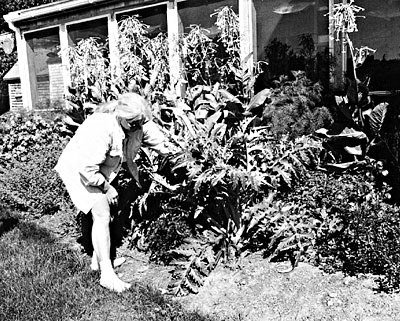 |
| Ellin explains the dramatic effect of cardoon. Lamb photo. |
“They’re my favorite vegetable,” Stephen confesses.
“That’s why we have them as part of our logo,” Ellin continues. “Before I knew it, he was starting tomatoes and peppers from seed, filling up my garden with his stuff. We definitely needed more space.” It was by now their garden.
“It was only about 10 by 20 feet,” Stephen recalls. “We had four or five little raised beds because the dirt was impossible. We did our first compost heap, the only one in the town. We traded vegetables for grass clippings because we didn’t have anything to put on it. That’s how we got started.” Now, still unable to produce the quantities they need for 2 acres of growing things, they buy compost from the Lincoln County Recycling Center.
Gardening was the Sheehys’ priority from the beginning, but not necessarily the standard variety. MOFGA-certified-organic, Anniversary Farm operates on the “small is beautiful” principle as well as on the dictum “be creative, adventurous and have fun.” “We’ve been playing with artichokes,” says Stephen. “We’ve produced them here, but I don’t think they could be a commercial crop. I grow them like tomatoes – plant seeds in early spring, then transplant them into the garden. They have to be grown as annuals.” He’s managed to winter over a couple in an unheated hoop house, inside a cold frame and heavily mulched. While they may not be worth all that effort, they’re fun to grow, Stephen insists. “People come by and say ‘Oh, my God, you’re growing artichokes!’ The flower is beautiful and the foliage is attractive.”
Heirloom vegetables and amazing flora, such as a 6-foot Nicotiana sylvestris keep the Sheehys adventuring. They grow potatoes only as “new potatoes.” Stephen has no intention of growing 30 acres of storage potatoes, he declares. “Since we’re the new people on the block,” says Ellin, “we aren’t going to look at the neighbor who raises llamas or sheep or grows mixed vegetables and say, ‘I’m going to do that, too.’ The end result is everybody’s prices go down or you just can’t sell it. We’re trying to find niches where our neighbors and friends aren’t growing the same things. And also, because we sell a lot of processed food, we’re not in the same market as they are.”
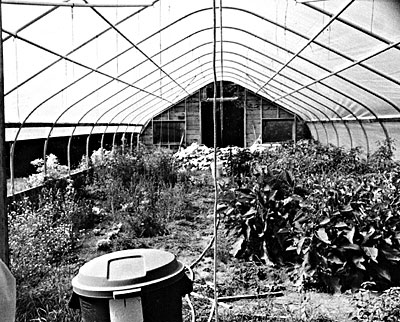 |
| Peppers flourish in a hoop house in September. Lamb photo. |
Hoop Houses
The Sheehys are looking at another niche. They hope to extend the growing season by three weeks at each end. They have had great success with greens and lettuces. Sown in September in the unheated hoop house, the lettuce sprouts, freezes in midwinter and, come spring, revives miraculously for the early market. ”We have heads that look like wedding bouquets,” Stephen brags, “so big we can only get one in a shopping bag.” In the unheated hoop house, the only requirement for winter survival is sufficient moisture, which comes from the abundant water underground. Last year they wholesaled small quantities of vegetables for the first time. “When the neighbors are done for the season, we want to continue supplying our gourmet markets, like the Rising Tide Coop,” Stephen says. “Those are the kinds of places we like to cultivate. We’re not interested in wholesaling big quantities of inexpensive vegetables. We can’t afford to grow them that way or to hire the help to do it.”
What Ellin and Stephen prefer to do is plant what they enjoy growing and eating. They love hot peppers, but they haven’t found much of a market for them in their area. They grow all kinds of peppers anyway – multi-colored ‘Pretty in Purple,’ early little sweet, red ‘Jingle Bells,’ some super-hot ones from Colorado – as much for their color as for cooking. “You can’t beat a greenhouse for peppers,” Stephen says. “Outside it’s hard to get them to ripen to red before frost. In the greenhouse we get red peppers in a month.” Basil, lettuce, mescluns, arugula, cilantro and parsley all thrive as well in the hoop house devoted to greens. In the other they grow all their tomatoes – none outdoors. Along with the usual varieties and the heirlooms, they raise a remarkable paste tomato they call ‘Dad’s Barber.’ Ellin’s father’s barber got the seeds from his mother in Italy. A true paste tomato, solid meat with only a tiny seed cavity, they weigh at least a pound, sometimes as much as two, five times the size of ‘Roma,’ says Stephen. The seeds are available from the Maine Seed Saving Network (P.O. Box 126, Penobscot ME 04476).
“They were Roberta Bunker’s organic pick of the year a couple of years ago,” Ellin adds. “They’re the perfect paste tomato.” She cuts them in quarters, removes the seeds, and bakes them at 350 degrees, leaving the skins on, until most of the moisture is gone. Then she drains off the liquid and puts them through a sieve or into a blender to make a thick paste. “I make it right into spaghetti sauce and can it to sell in the farm stand. And we eat tons of it all winter.” It’s a big operation in September when all the ingredients – tomatoes, onions, peppers, basil, garlic and oregano are on hand. “We grow everything in the sauce,” she says proudly. Ellin keeps a supply of sweet peppers all winter by slicing them in half, baking them on a tray for about half an hour at 350 degrees, then freezing them right on the tray. After they’re frozen, they can be put into ziplock bags. “They can actually be used in a salad, though they’re not exactly like a fresh pepper. And they go well in sauces,” she says.
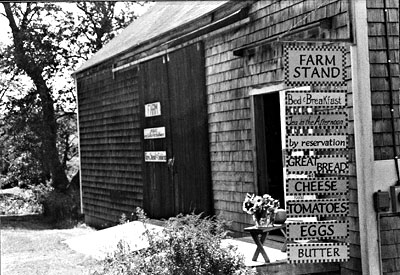 |
| The farm stand for Anniversary Farm is beside Route 216 in Alna. Lamb photo. |
We Eat First
“The first year we ate everything out of the garden,” Ellin says. “Then I got too busy in farmers’ market, and one year we found we hardly ate anything from the garden. We were so exhausted we went out to dinner – the most ridiculous thing in the world when there’s all this great food at home.” After several hectic years of overcommitment, the Sheehys have achieved a balance. ”This is the first year we fed ourselves first, then the kids who work here.” Two high school students, whom they praise highly, work for them in the summers, planting, weeding, harvesting, and tending the stand. “They can pick and take home whatever they want for free, or buy what’s already picked at half price. Their families can do that too. After everybody has what they want, then we sell the rest. We had the first asparagus until we were sick of it, then they got it and then it went into the stand. It’s been great to get back to going out shopping in the garden for your dinner.”
In her first surge of enthusiasm six years ago, Ellin was eager to try everything – farmers’ markets, a farm stand, a tea room. Before she knew it, she found herself spending 50 hours a week at four farmers’ markets, serving as secretary of MOFGA’s board of directors, president of the Damariscotta farmers’ market, and a member of the board of Seed Saving Network – and tending the farm and the farm stand and trying to run a tea room. “I was becoming a lunatic,” Ellin reports. She gave up the farmers’ markets so that people would come to the farm for their produce instead, and thus gained 50 hours she could spend at home, concentrating on things that worked better. The tea room, now available by appointment only, was dropped in favor of the bed and breakfast. “Who wanted to drink tea when it was 100 degrees in summer, even when we served ice tea?” she asks. She has stayed involved in the Head Tide church and the Sheepscot Valley Conservation Association, but life has become calmer. The Sheehys now have more time for the column they both write, “Fresh from the Market,” for the Lincoln County News, about cooking, local farming and gardening.
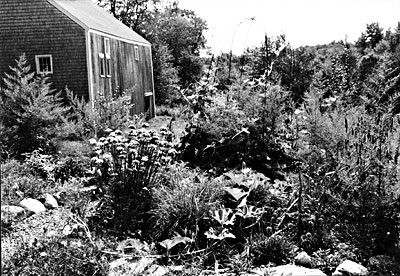 |
| Rich colors and textures fill the gardens. Lamb photo. |
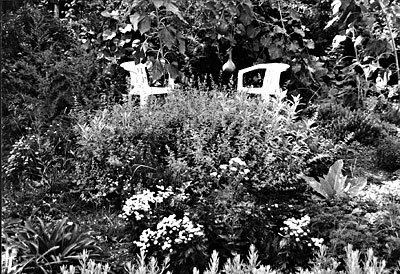 |
More Than a Farm
“Last year was great,” says Ellin. “We probably didn’t sell as many vegetables but the farm is getting under control. We have time now to do the gardens at the farm, so people can have something to see when they come here.” And there’s plenty to see, not only for regular farm stand customers, but for B&B guests as well. “Our emphasis is on organically grown, small gardens for homeowners [rather than larger farm operations],” she notes. “We’re trying to have gardens so people will enjoy walking through when they come to buy vegetables, pick herbs. That’s why we’ve been working on landscaping. The whole farm is the experience they come to see.”
Beside the road is the small, trim barn the Sheehys were able to restore for the farm stand. The big, two-story farmhouse with its long, sun-porched el and attached barn sits up the slope, overlooking flower, herb and vegetable beds and the pond in the hollow below. Gardens surround old wagon wheel rims and a mill wheel excavated on the property, a repeated circular pattern that’s echoed in the walk winding up to the main entrance. Tiffany Canada, one of the high school students who worked for them, dug the walkway by hand and helped Stephen lay the stones. ”We’re going to have a little plaque made that says ‘Tiffany dug this walk.’ She was so proud of herself,” he says.
Ellin, who has a degree in art and has employed it in a dozen different ways, designs the gardens with an eye for colors and textures. She likes to highlight individual flowering plants against contrasting foliage. “This is a blue and white garden that will have just touches of pink,” she says, pointing out the low blue catmint, dramatic fronds of cardoon (an ornamental relative of the artichoke) and tall candelabras of white nicotiana in front of the sun porch. “The wonderful scent of the nicotiana is an added dimension. It wafts through the garden and even into the house when the windows are open.” Scented flowers and herbs, many of which are available on a pick-your-own basis, abound throughout the gardens. Dill and cilantro perfume vegetable beds.
A walk through the grounds reveals charming little plots in the angles of buildings and woodsy nooks around the lawns. One of their first landscaping projects was a low stone wall where thyme grows among hostas in partial shade “We’ve been fans of the Nearings since the1960s,” Ellin says, “and after reading Helen’s book, actually convinced ourselves we could build our first house. We’ve always been jealous of their stone walls. There’s not a stone on this place. Four feet of topsoil is nice for growing, but we had to have our token stone wall.” In another corner, birdhouse gourds climb a trellis made of bent rebar (Stephen recommends 3/8-inch as easiest to shape) and adirondack chairs invite a stop in the herb garden. Ellin turns the gourds into birdhouses and decorates them to sell in the farm stand. Fast-growing gourds and sunflowers can make a new garden look well-established in a hurry, she points out.
Stephen would like to raise tea roses, which he grew in Massachusetts, but for now has settled for the hardier shrub roses that look good around the old house. “We’re trying to create some miniclimates. Sometime when we have more time on our hands we might try tea roses again.” One of their successes has been spectacular hollyhocks, another old fashioned flower that is well suited to the setting. Surprisingly, hollyhocks can be made to last up to two weeks as cut flowers by searing the cut stems in a flame.”If you don’t burn the ends, they don’t last more than a couple of hours,” Ellen notes.
Behind the house are more vegetable gardens, the two hoop houses and, moving up the hillside, plots of everbearing strawberries and raspberries, corn and potatoes. “Growing corn organically is tricky,” says Stephen. He’s found a couple of tightly-husked varieties, such as ‘Tuxedo’ that tend to keep out earworms. Ringing his corn patch with winter squash and pumpkins deters ravaging raccoons, he thinks. “They don’t like to walk across the foliage.” Stephen hires a local farmer to till growing beds with a tractor – “Part of our philosophy of not being too capital intensive,” he explains. “We’re pretty small. Rather than spending three days with a rototiller [and investing in it in the first place], somebody can spend five minutes with a big tractor.” He prepares a bed for planting with a first-year sowing of field peas, oats and vetch. Gardens that can be harvested early enough also receive a cover crop for the rest of the season. The Sheehys don’t use manure because of the weed content, the risk of E. coli, and because they don’t have animals. “We’re too soft-hearted. They’d be with us forever. We don’t eat anyone we know!” Though they’re not vegetarians, they don’t eat a lot of meat, and they buy all they need from friends and neighbors.
Enjoying Eden
While Ellin’s family always gardened organically and she never even thought of doing otherwise, Stephen’s awakening came in a flash he remembers clearly. He was trying to grow tea roses in Massachusetts and was so frustrated by their numerous maladies that he purchased “some nasty stuff in a red can. I looked at the roses, right next to the lettuce, and began reading the warning labels on the can,” he relates. “I couldn’t spray this on something I was going to eat, so back to the store it went. It never occurs to us to put anything on our plants that we would worry about eating. It’s really easy to be organic because the alternative is really kind of repulsive.” Together the Sheehys have concluded that leaving all the “little critters” they live among alone to work out a rough balance is the best way to go. “We don’t even use plant-based insecticides,” Ellin says. “Anything that’s broad-based is going to kill the good guys as well as the bad guys.” They do use Bt on potato beetles, but sparingly, since they grow only “new” potatoes that are harvested early in the season before the beetle problem gets acute.
Larger critters Ellin and Stephen are delighted to have with them. They enjoy watching ospreys catch the trout they stock in the pond for catch and release fans, especially kids. A family of beaver dammed the pond one year and raised the water level so high that the ground became supersaturated and took out the dam with a California-style mudslide. Heavy equipment working on repairs discovered the old overflow pipe and put it back in business to keep the water at the desirable level. The beaver came back, took one look, and disappeared.
Deer are no problem. Though they eat some of the cover crops, Stephen thinks there’s enough for them to eat at the edges of the fields near the shelter of woods so that they don’t feel like going into the gardens. He has the fields mowed every couple of years to keep them open; he only mows walking paths through the tall grass and wildflowers in the interim. Woodchucks caused a lot of trouble at first, but as long as a patch of unmowed dandelions and clover is left near the woodchuck’s den, the animals stay close to home. One woodchuck has become rather a pet, having staked out a claim to a small, fenced in broccoli garden. He dug under the fence and spends his summers there, leaving the other crops alone. A fox family entertained them one summer, crossing through the garden regularly. “We were having dinner in the dining room one day with a whole bunch of guests,” Stephen recalls. “We looked out and right next to the driveway was the whole fox clan.” He figures the foxes help to control the woodchucks. “One of the great things about being here is the wildlife. We feel as though we have a whole little ecosystem here.” They hear, but never see, coyotes and wild turkeys. In fact, they’re building a little cabin in a back field where they can sit on the porch and watch the passing parade of deer, foxes, chipmunks and their friends.
People can be just as fascinating for Ellin and Stephen as the wildlife. “The B&B has been great,” says Ellin. They have only two or three rooms so it’s not overwhelming and people come from all over – Louisiana, North Carolina, Europe. Stephen tells about a couple from Germany who were living in Quincy [Mass.] without a car. “We picked them up at the bus and they spent a whole weekend. They were real Europeans. They walked! They’d go out for a walk in the morning and come back in late afternoon.”
Ellin continues. “They loved having a fireplace in their room. They came because Erik was from Dresden, Germany, and saw Dresden Bog on the map. We were close enough for them to walk over there to see it. They’d traveled all over the country this way. We told them they should write a book about being able to travel in America as Europeans, without a car!”
Anniversary Farm has brought the Sheehys interesting people, home-grown food, an outlet for their abundant produce, their own unofficial wildlife refuge, endless opportunities to be creative in business. “It’s a lot of fun having a lot going on,” says Ellin when asked about the art adorning the walls of the sun porch-tea room. Carved fish by Tom Benne of Whitefield pay tribute to occupants of the pond below. Hooked rugs by his wife, Paula, and quilts and other work by local artists are regularly displayed in the informal art gallery. “I have a lot of skills I spent my life honing,” says Ellin. “Crafts, painting, upholstery, cooking. Especially cooking. The farm seems to bring together all these skills that were just disjointed hobbies.” Stephen has no end of carpentry projects ahead of him, when he’s not plotting another strategy for growing winter vegetables or catching the bus to Boston or figuring how to rescue a collapsing blacksmith shop on the other side of the town line, reputed to be the oldest building in Whitefield. (They pay taxes in both towns.)
Ellin sums up the joys of life at Anniversary Farm. “We’re both very creative. We never feel stuck doing one thing. We keep our careers open ended. It’s fun to have done a lot of things, a lot I would never do again, but it’s interesting to know you’re not stuck in one place.”
About the author: Jane Lamb wrote features for The MOF&G regularly. She now lives in California.
